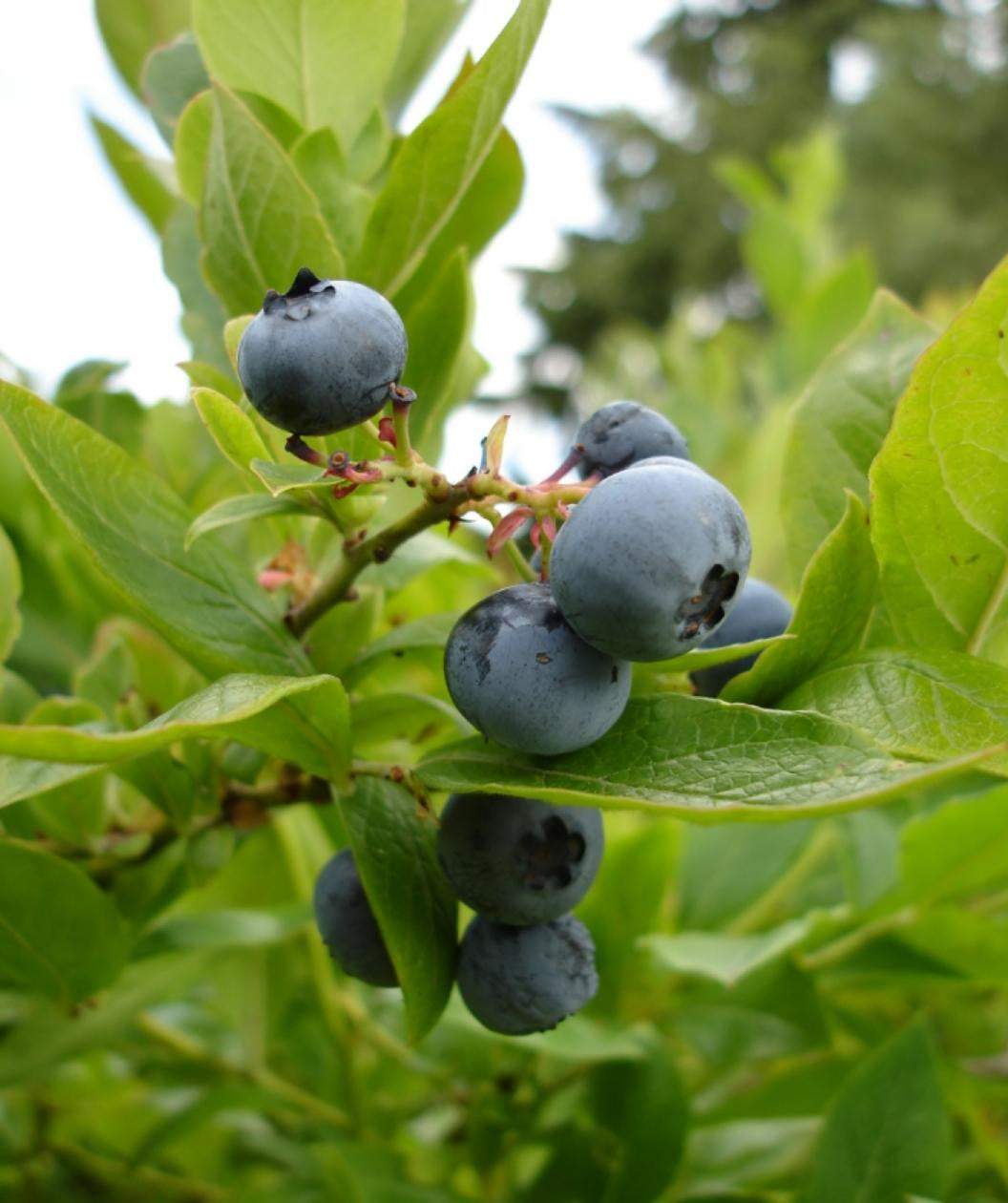A classic highbush blueberry celebrated for its abundant harvest, sweet flavor, and fiery fall color that brightens every garden
FEATURES:
- Sold in bundles
- Known as one of the most productive and flavorful varieties
- In May, white bell-shaped flowers will bloom, attracting the bees
- Following the blooms, the berries begin to emerge and are ready for harvest in mid-summer
- Berries are wonderful in jams and jellies, baking or eating fresh off the plant
- Self-pollinating but when planted with others, will yield a larger harvest
- Dark green leaves turn bright shades of red come fall
- Hand-selected, Fresh from our Grower
- Due to federal and state laws, we are unable to ship to: GA, MI
Bower & Branch Landscape Design Tip
Plant Bluecrop in full sun with rich, well-drained acidic soil. If your soil is not naturally acidic, amend it with peat moss or a soil mix formulated for azaleas and rhododendrons. Keep the soil consistently moist, especially during flowering and fruiting. Apply mulch to help retain moisture and protect the roots. Prune lightly in late winter to remove old or weak branches and encourage new growth. While Bluecrop is self-pollinating, planting it near another blueberry variety can increase yields and improve fruit size. Its versatility and beauty make it a must-have for every home orchard.
Growth Facts
- Hardiness Zone: 4-8
- Mature Height: 4-6' tall
- Mature Width: 3-4' wide
- Exposure: Full Sun/Partial Shade
- Spacing: 3-4' apart
A classic highbush blueberry celebrated for its abundant harvest, sweet flavor, and fiery fall color that brightens every garden
FEATURES:
- Sold in bundles
- Known as one of the most productive and flavorful varieties
- In May, white bell-shaped flowers will bloom, attracting the bees
- Following the blooms, the berries begin to emerge and are ready for harvest in mid-summer
- Berries are wonderful in jams and jellies, baking or eating fresh off the plant
- Self-pollinating but when planted with others, will yield a larger harvest
- Dark green leaves turn bright shades of red come fall
- Hand-selected, Fresh from our Grower
- Due to federal and state laws, we are unable to ship to: GA, MI
Bower & Branch Landscape Design Tip
Plant Bluecrop in full sun with rich, well-drained acidic soil. If your soil is not naturally acidic, amend it with peat moss or a soil mix formulated for azaleas and rhododendrons. Keep the soil consistently moist, especially during flowering and fruiting. Apply mulch to help retain moisture and protect the roots. Prune lightly in late winter to remove old or weak branches and encourage new growth. While Bluecrop is self-pollinating, planting it near another blueberry variety can increase yields and improve fruit size. Its versatility and beauty make it a must-have for every home orchard.
Growth Facts
- Hardiness Zone: 4-8
- Mature Height: 4-6' tall
- Mature Width: 3-4' wide
- Exposure: Full Sun/Partial Shade
- Spacing: 3-4' apart
Why plant Bluecrop Highbush Blueberry?
Blueberry pancakes, blueberry muffins, blueberry cobbler, or fresh blueberries for summertime snacking! Bluecrop Highbush Blueberry will bring delectable fruits right outside your door. Bluecrop is a classic variety with excellent flavor and that delicate balance of sweet and tart that makes blueberries so addictive. In fall, you’ll get a feast for the eyes when Bluecrop’s deep green leaves turn tomato-red. Plant this awesome Accent in a prominent spot, where the brilliant autumn foliage will garner oohs and ahhs, and the berries will be conveniently close for easy picking. So pretty, so tasty, so satisfying.
How to use Bluecrop Highbush Blueberry in the landscape?
Take the time to appreciate Bluecrop Highbush Blueberry’s exquisite flowers in the spring. The dainty white blossoms, shaped like tiny, upside-down urns, make a pleasing show. Honey bees love the blooms, and they get right to work pollinating them.
How To Plant Bluecrop Highbush Blueberry
Acid soil is key to growing Blueberries successfully. These peat-loving Accents require very low–pH conditions in order to thrive. If your soil isn’t naturally acidic, you may want to grow Bluecrop Blueberry in a large container or raised bed. Give it all-day sun if possible and use lots of organic matter—both as a soil amendment and as mulch. Bluecrop Blueberry is self-pollinating, but you’ll get bigger fruits and more of them if you plant another variety of Highbush Blueberry nearby so they can pollinate each other.
How To Water
Water twice weekly for the first 3-5 weeks; then water weekly for the remainder of the year until winter. When you water, water very slowly and very thoroughly. The water needs to reach to the bottom of the root ball and that takes time. Watering needs may be altered due to extreme weather conditions.
How To Prune
Not much pruning is required, however, you can prune in late winter to early sprung to thin out the branching. This will help maintain the plant size and make harvesting easier.
Frequently Asked Questions
Yes. Bluecrop is self-pollinating and will produce fruit on its own. However, planting another variety nearby can increase yield and improve berry size and sweetness.
Bluecrop is a midseason variety that typically ripens in July, providing a large, consistent harvest in the heart of summer.
Bluecrop thrives in acidic soil with a pH between 4.5 and 5.5. If your soil is neutral or alkaline, amend it with peat moss, pine bark, or an acid-based planting mix.





